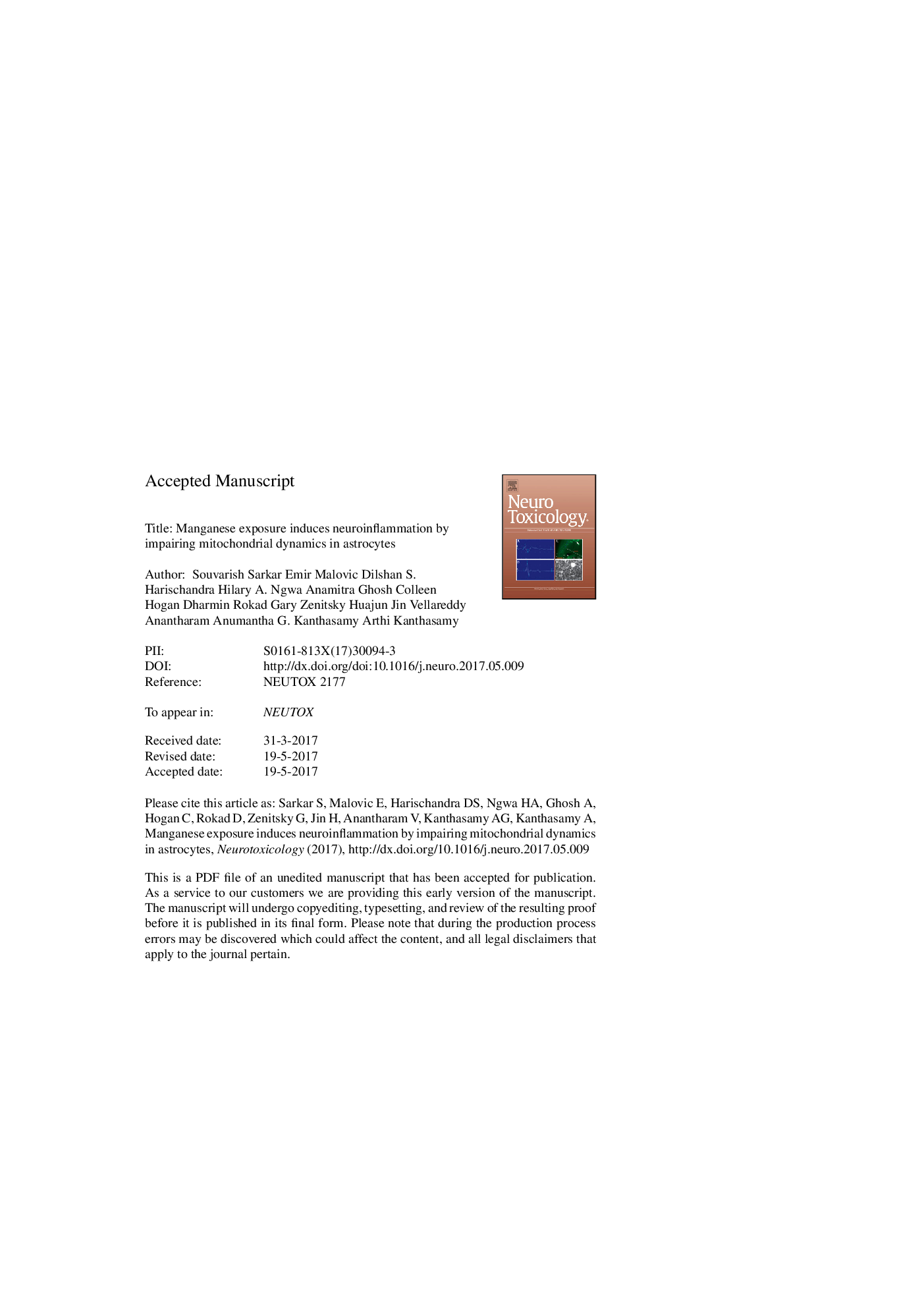| کد مقاله | کد نشریه | سال انتشار | مقاله انگلیسی | نسخه تمام متن |
|---|---|---|---|---|
| 8550383 | 1562030 | 2018 | 50 صفحه PDF | دانلود رایگان |
عنوان انگلیسی مقاله ISI
Manganese exposure induces neuroinflammation by impairing mitochondrial dynamics in astrocytes
ترجمه فارسی عنوان
قرار گرفتن در معرض منگنز موجب التهاب عصبی توسط اختلال در پویایی میتوکندری در آستروسیت ها می شود
دانلود مقاله + سفارش ترجمه
دانلود مقاله ISI انگلیسی
رایگان برای ایرانیان
کلمات کلیدی
موضوعات مرتبط
علوم زیستی و بیوفناوری
علوم محیط زیست
بهداشت، سم شناسی و جهش زایی
چکیده انگلیسی
Chronic manganese (Mn) exposure induces neurotoxicity, which is characterized by Parkinsonian symptoms resulting from impairment in the extrapyramidal motor system of the basal ganglia. Mitochondrial dysfunction and oxidative stress are considered key pathophysiological features of Mn neurotoxicity. Recent evidence suggests astrocytes as a major target of Mn neurotoxicity since Mn accumulates predominantly in astrocytes. However, the primary mechanisms underlying Mn-induced astroglial dysfunction and its role in metal neurotoxicity are not completely understood. In this study, we examined the interrelationship between mitochondrial dysfunction and astrocytic inflammation in Mn neurotoxicity. We first evaluated whether Mn exposure alters mitochondrial bioenergetics in cultured astrocytes. Metabolic activity assessed by MTS assay revealed an IC50 of 92.68 μM Mn at 24 h in primary mouse astrocytes (PMAs) and 50.46 μM in the human astrocytic U373 cell line. Mn treatment reduced mitochondrial mass, indicative of impaired mitochondrial function and biogenesis, which was substantiated by the significant reduction in mRNA of mitofusin-2, a protein that serves as a ubiquitination target for mitophagy. Furthermore, Mn increased mitochondrial circularity indicating augmented mitochondrial fission. Seahorse analysis of bioenergetics status in Mn-treated astrocytes revealed that Mn significantly impaired the basal mitochondrial oxygen consumption rate as well as the ATP-linked respiration rate. The effect of Mn on mitochondrial energy deficits was further supported by a reduction in ATP production. Mn-exposed primary astrocytes also exhibited a severely quiescent energy phenotype, which was substantiated by the inability of oligomycin to increase the extracellular acidification rate. Since astrocytes regulate immune functions in the CNS, we also evaluated whether Mn modulates astrocytic inflammation. Mn exposure in astrocytes not only stimulated the release of proinflammatory cytokines, but also exacerbated the inflammatory response induced by aggregated α-synuclein. The novel mitochondria-targeted antioxidant, mito-apocynin, significantly attenuated Mn-induced inflammatory gene expression, further supporting the role of mitochondria dysfunction and oxidative stress in mediating astrogliosis. Lastly, intranasal delivery of Mn in vivo elevated GFAP and depressed TH levels in the olfactory bulbs, clearly supporting the involvement of astrocytes in Mn-induced dopaminergic neurotoxicity. Collectively, our study demonstrates that Mn drives proinflammatory events in astrocytes by impairing mitochondrial bioenergetics.
ناشر
Database: Elsevier - ScienceDirect (ساینس دایرکت)
Journal: NeuroToxicology - Volume 64, January 2018, Pages 204-218
Journal: NeuroToxicology - Volume 64, January 2018, Pages 204-218
نویسندگان
Souvarish Sarkar, Emir Malovic, Dilshan S. Harischandra, Hilary A. Ngwa, Anamitra Ghosh, Colleen Hogan, Dharmin Rokad, Gary Zenitsky, Huajun Jin, Vellareddy Anantharam, Anumantha G. Kanthasamy, Arthi Kanthasamy,
